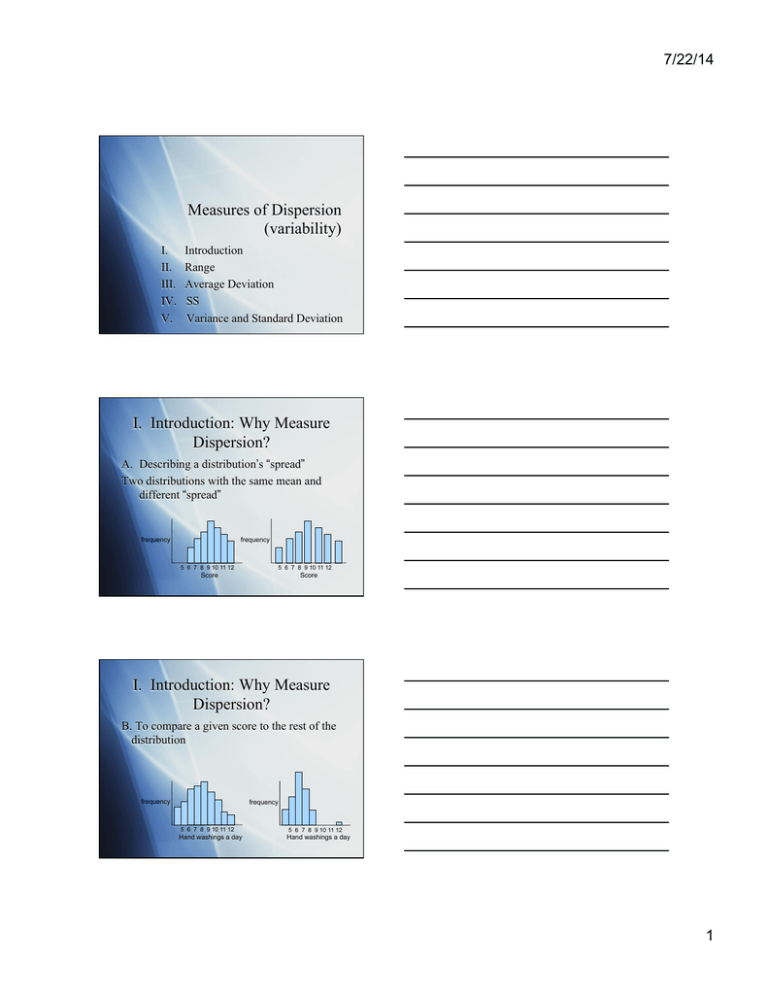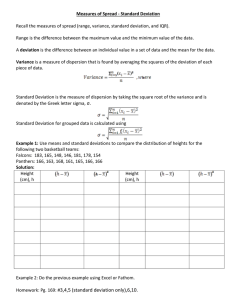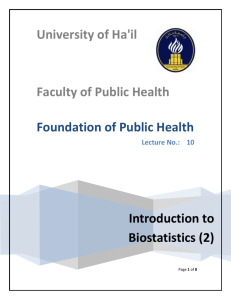Measures of Dispersion (variability) I. Introduction: Why Measure Dispersion?
advertisement

7/22/14 Measures of Dispersion (variability) I. II. III. IV. V. Introduction Range Average Deviation SS Variance and Standard Deviation I. Introduction: Why Measure Dispersion? A. Describing a distribution’s “spread” Two distributions with the same mean and different “spread” frequency frequency 5 6 7 8 9 10 11 12 5 6 7 8 9 10 11 12 Score Score I. Introduction: Why Measure Dispersion? B. To compare a given score to the rest of the distribution frequency frequency 5 6 7 8 9 10 11 12 5 6 7 8 9 10 11 12 Hand washings a day Hand washings a day 1 7/22/14 I. Introduction: Why Measure Dispersion? C. To make informed decisions: Two routes to campus - same average time frequency frequency 5 6 7 8 9 10 11 12 Time (min) 5 6 7 8 9 10 11 12 Time (min) Measures of Dispersion Range: describes the spread by contrasting the two most extreme scores Three ways to report it 1. Give both scores “The grades ranged between 56 and 97.” 2. The highest score minus the lowest score: 97-56 = 41 Note, to be accurate, you should use the upper real limit of the high number and the lower real limit of the low number. 10.5 - 4.5 = 6 range 2 7/22/14 Measures of Dispersion Range (continued) 3. High score - Low score + 1 If the scores are integers, adding 1 adds in the upper and lower real limits. Examples: 10-5+1 = 6 if 97.5 is the URL, and 55.5 the LRL then 97.5-55.5 = 42 and 97-56+1 = 42 NOTE: This is the convention we will use in this course! Measures of Dispersion Problems with the range: 1) Completely determined by extreme scores. 2) Not very useful for describing the shape of the distribution or drawing conclusions. Measures of Dispersion Average deviation: Average distance each score is from the mean of the distribution. x x-M 8 8-3 = 5 5 1 1-3 = -2 2 3 3-3 = 0 0 0 0-3 = -3 3 0 10 ∑= 12 M = 12/4 = 3.0 |x-M| Av. Dev. = 10/4 = 2.5 3 7/22/14 Measures of Dispersion Average Deviation (continued) Conceptually very useful (closely related to the standard deviation), but it is unstable under sampling. Measures of Dispersion SS (sum of the squared deviations) (x-M)2 x x-M 8 8-3 = 5 25 1 1-3 = -2 4 3 3-3 = 0 0 0 0-3 = -3 9 0 38 ∑= 12 SS = ∑(x-M)2 = 38 M = 12/4 = 3.0 Measures of Dispersion Variance (σ2) Population Variance is the average of the squared deviations from the mean. σ2 = ∑(x-M)2 = N SS/N (N = population size) example 38/4 = 9.5 4 7/22/14 Measures of Dispersion Standard Deviation (σ) for a population Square root of variance σ = √ σ2 √ ∑(x-M)2 N = = Example: √ss/N √9.5 = 3.08 Measures of Dispersion Summary Range = high-low+1 SS = ∑(x-M)2 Population Variance: σ 2 = SS/N Standard Deviation: σ =√SS/N Measures of Dispersion Example problem: Calculate the range, SS, variance, and standard deviation for the following populations of scores: Range Mean SS Var Std Group 1 1 9 5 8 7 9 6 Group 2 6 9 5 8 7 5 7 8 2.83 2 1.41 5 7/22/14 Measures of Dispersion Visualizing what the standard deviation measures. - about halfway to the range - the point of inflection on a frequency graph - most of the scores (68 %) should fall within 1 standard deviation of the mean. (data from 1991 U.S. General Social Survey courtesy of SPSS) 6 7/22/14 Measures of Dispersion SS and the computational formula Definition: SS = ∑(x-M)2 Computational: SS = ∑x2 - (∑x)2/N Examples: 7 7/22/14 Measures of Dispersion Degrees of freedom and populations estimates Definition: number of pieces of information that are free to vary. Example: cafeteria line Measures of Dispersion Degrees of freedom and deviations scores x x-M 2 -2 4 0 6 ∑ = 12 df = 2 2 ∑ = (x - M) = 0 M = 12/3 =4 Measures of Dispersion Because deviation scores are based on the mean, once I have calculated the mean I have reduced my degrees of freedom by one. Thus, in sample estimates of variance, the degrees of freedom are n-1. In general df = n - 1 8 7/22/14 Measures of Dispersion Define: s2 = sample variance = SS/n-1 s = sample standard deviation = √ SS/n-1 Measures of Dispersion Summary Range = high-low+1 SS = ∑(x-M)2 Variance: Population Sample σ 2=SS/N s2=SS/n-1 Standard Deviation: σ =√SS/N s= √SS/n-1 Measures of Dispersion Sample Problems: 9 7/22/14 Measures of Dispersion Factors Affecting Variability 1. Sample Size a) Range increases with sample size b) Variance decreases with sample size 2. Extreme scores - greatly influence most measures, especially range 10







